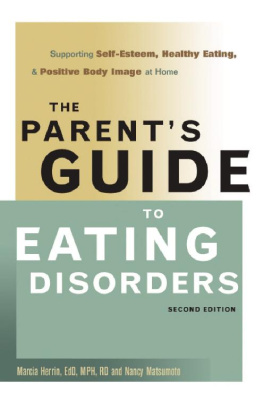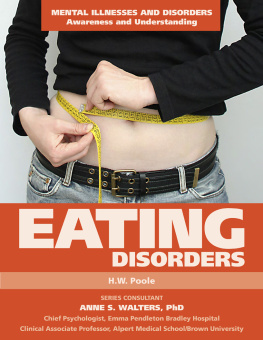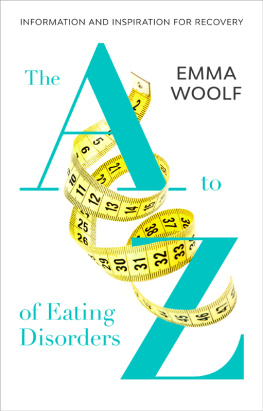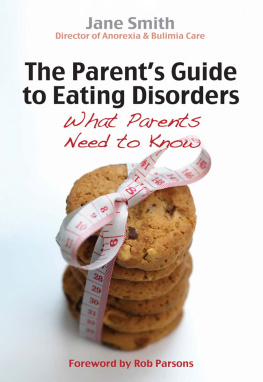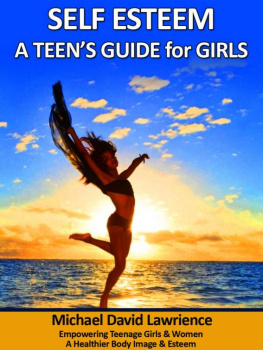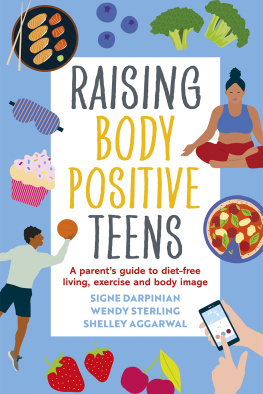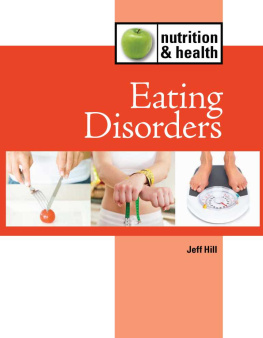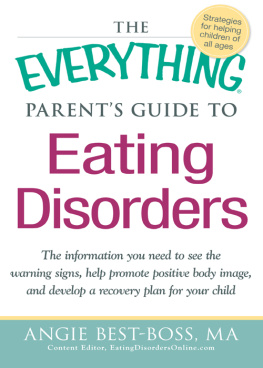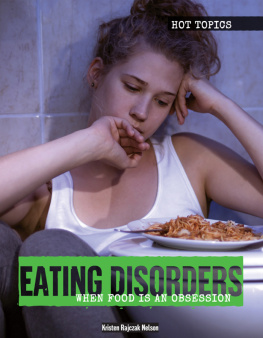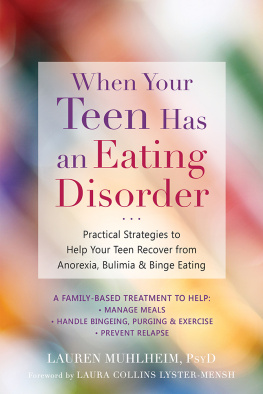Acknowledgments
We are greatly indebted to the many patients and their parents whose stories and struggles have both taught and inspired us; we hope this book succeeds in passing on some of their accumulated wisdom.
We are proud to have Lindsey Hall and Leigh Cohn of Grze Books as our partners in publishing this second edition. Their book displays at major eating disorder conferences are a gathering place for professionals who care deeply about this field, and are a reflection of their immense contribution to our chosen field.
Although we knew what important and influential publishers they were, we were delighted to find that Leigh is also an editor par excellence. His rare combination of expertise in the subject matter and superb editing skills made the editing process an especially productive and satisfying experience. Lindsey and Leighs understanding of and commitment to our shared goalsto educate and help those suffering from eating disorders, and those who love themhas made working with them on this book a pleasure. In addition, wed like to thank New York nutritionist Wendy Meyer Sterling, MS, RD, CDN, of North Shore-Long Island Jewish Health System, Schneider Childrens Hospital, for her valuable counsel in updating sections on calcium and bone loss.
We also thank those who sacrificed the most to make this book possible, our families. We are especially grateful to our husbands, Alan and Grant, who believed in us and helped us believe in ourselves. To our children, Branch, Gretta, and Sandy, who understood why it was important for their moms to spend such long hours on the computer.
About the Authors
Marcia Herrin, EdD, MPH, RD founded the Dartmouth College Eating Disorders Prevention, Education, and Treatment Program. A frequent expert guest on national media and author of Nutritional Counseling in the Treatment of Eating Disorders, she lives in New Hampshire.
Nancy Matsumoto has written for People magazine, The New York Times, and other publications. She lives in New York City.
Bibliography
American College of Sports Medicine. (1998). Position stand: The recommended quantity and quality of exercise for developing and maintaining cardiorespiratory and muscular fitness, and flexibility in healthy adults. Medicine and Science in Sports and Exercise 30, 975-91.
American Psychiatric Association. (1994). Diagnostic and statistical manual of mental disorders (4th ed.). Washington, D.C.
American Psychiatric Association. (2006). Practice guideline for the treatment of patients with eating disorders (3rd ed.). Washington, D.C.
Andersen, A. E., Watson, T., and Schlechte, J. (June 3, 2000). Osteoporosis and osteopenia in men with eating disorders. The Lancet 355, 1967-68.
Beals, K. A., and Meyer, N. L. (2007). Female athlete triad update. Clinics in Sports Medicine 26, 69-89.
Birch, L. L., and Fisher, J. O. (2000). Mothers child-feeding practices influence daughters eating and weight. American Journal of Clinical Nutrition 71, 1054-61.
Bo-Linn, G. W., Santa Ana, C. A., Morawski, S. G., and Fordtran, J. S. (1983). Purging and calorie absorption in bulimic patients and normal women. Annals of Internal Medicine 99, 14-17.
Bostic, J. Q., Muriel, A. C., Hack, S., Weinstein, S., and Herzog, D. (1997). Anorexia nervosa in a 7-year-old girl. Journal of Developmental and Behavioral Pediatrics 18, 331-33.
Brambilla, F., Draisci, A., Peirone, A., Brunetta, M. (1995). Combined cognitive-behavioral, psychopharmacological and nutritional therapy in eating disorders. Biological Psychiatry 32, 59-63.
Brumberg, J. J. (1988). Fasting girls. Cambridge, Mass.: Harvard University Press.
Bulik, C. M., Sullivan, P. F., Carter, F. A., McIntosh, V. V., and Joyce, P. R. (1999). Predictors of rapid and sustained response to cognitive-behavioral therapy for bulimia nervosa. International Journal of Eating Disorders 26, 137-44.
Byely, L., Archibald, A. B., Graber, J., and Brooks-Gunn, J. (2000). A prospective study of familial and social influences on girls body image and dieting. International Journal of Eating Disorders 28, 155-64.
Carlat, D. J., Camargo, C. A., Jr., and Herzog, D. B. (1997). Eating disorders in males: A report on 135 patients. American Journal of Psychiatry 154, 1127-32.
Collins, L. (2005). Eating With Your Anorexic. New York: McGraw-Hill.
Crow, S. J. (2006). Fluoxetine treatment of anorexia nervosa: Important but disappointing results. Journal of the American Medical Association 295, 2659-60.
Davis, C., Kennedy, S. H., Ravelski, E., and Dionne, M. (1994). The role of physical activity in the development and maintenance of eating disorders. Psychological Medicine 24, 957-67.
Eisenberg, M. E., Neumark-Sztainer, D., Story, M., and Perry, C. (2005). The role of social norms and friends influences on unhealthy weight-control behaviors among adolescent girls. Social Science & Medicine 60, 1165-73.
Eisenberg, M. E., Rachel E. Olson, R., E., Neumark-Sztainer, D., Story, M., and Bearinger, L. H. (2004). Correlations between family meals and psychosocial well-being among adolescents. Archives of Pediatrics & Adolescent Medicine 158, 792-96.
Fairburn, C. G., Marcus, M. D., and Wilson, G. T. (1993). Cognitive-behavioral therapy for binge eating and bulimia nervosa: A comprehensive treatment manual. In C. G. Fairburn and G. T. Wilson, eds., Binge eating: Nature, assessment and treatment (pp. 361-404). New York: Guilford Press.
Fichter, M. M., Quadflieg, N., and Hedlund, S. (2006). Twelve-year course and outcome predictors of anorexia nervosa. International Journal of Eating Disorders 39, 87-100.
Field, A. E., Colditz, G. A., and Peterson, K. E. (1997). Racial/ethnic and gender differences in concern with weight and in bulimic behaviors among adolescents. Obesity Research 5, 447-54.
Fisher, J. O., and Birch, L. L. (1999). Restricting access to foods and childrens eating. Appetite 32, 405-19.
French, S. A., Story, M., Neumark-Sztainer, D., Downes, B., Resnick, M., and Blum, R. (1997). Ethnic differences in psychosocial and health behavior correlates of dieting, purging, and binge eating in a population-based sample of adolescent females. International Journal of Eating Disorders 22, 315-22.
Garner, D. M. (1997). Psychoeducational principles in treatment. In D. M. Garner and P. E. Garfinkel, eds., Handbook of treatment for eating disorders (2nd ed., pp. 145-77). New York: Guilford Press.
Gendall, K. A., Joyce, P. R., and Abbott, R. M. (1999). The effects of meal composition on subsequent craving and binge eating. Addictive Behaviors 24, 305-15.
Gidding, S. S., Dennison, B. A., Birch, L. L., Daniels, S. R., Gillman, M. W., Lichtenstein, A. H., Rattay, K. T., Steinberger, J., Stettler, N., and Van Horn, L. (2006). Dietary recommendations for children and adolescents: a guide for practitioners. Endorsed policy statement. Pediatrics 117, 544-59.
Golden, N. H., Katzman, D. K., Kreipe, R. E., Stevens, S. L., Sawyer, S. M., Rees, J., Nicholls, D., and Rome, E. S. (2003). Eating disorders in adolescents: Position paper of the Society For Adolescent Medicine. Journal of Adolescent Health 33, 496-503.
Golden, N., and Meyer, W. (2004). Nutritional rehabilitation of anorexia nervosa. International Journal of Adolescent Medicine and Health, 16, 131-44.
Gowers, S. G., Weetman, J., Shore, A., Hossain, F., and Elvins, R. (2000). Impact of hospitalisation on the outcome of adolescent anorexia nervosa.

